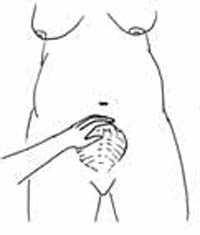3.1 Postpartum haemorrhage
Study Sessions 3 and 11 of the Labour and Delivery Care Module explained that a life-threatening postpartum haemorrhage (PPH) involves losing at least 500 ml of blood from the uterus or vagina. The most critical period to develop a PPH is during the third and fourth stages of labour.
What are the third and fourth stages of labour?
The third stage is delivery of the placenta and fetal membranes; the fourth stage is the next four hours.

About 90% of deaths due to PPH take place within four hours of delivery. During the first four to six hours, you should make sure that the uterus remains well contracted (Figure 3.1) and that there is no heavy loss of blood. However, a woman can develop a haemorrhage at any time during the puerperium, generally in the first week after delivery, but even up to six weeks postpartum. This type of bleeding is referred to as secondary (late) postpartum haemorrhage.
The presence of anaemia or a heart condition can be life-threatening for the mother even if the loss of blood is less than 500 ml. A woman who is malnourished is also usually less able to cope with blood loss than a woman who is well nourished.
Learning Outcomes for Study Session 3
